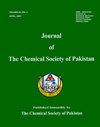铜- dmeda催化5-(3,4,5-三甲氧基苯基)-1,3,4-恶二唑-2-硫醇衍生化碳硫键的形成
IF 0.5
4区 化学
Q4 CHEMISTRY, MULTIDISCIPLINARY
Journal of the chemical society of pakistan
Pub Date : 2023-01-01
DOI:10.52568/0012132/jcsp/45.02.2023
引用次数: 0
摘要
硫化物键不仅在合成化学中起着重要的作用,而且作为一种具有药理活性的基团,在药物开发中有着广泛的应用。过渡金属催化硫基化是一项具有挑战性的任务,因为硫与过渡金属催化剂具有很高的亲和力,从而导致催化剂中毒。催化剂中毒导致反应活性和反应效用的抑制。本研究开发了一种简单易行的方法,利用杂芳基硫醇和取代芳基碘化物进行s -芳基化反应。采用不同的过渡金属催化剂和配体组合对反应条件进行了优化。不同的铜源包括CuCl、CuI和Cu(OAc)2不同的双齿氮基配体,包括联吡啶、二叔丁基联吡啶、DMEDA和肌氨酸。优化条件为:以CuI为催化剂,以DMEDA为配体。在高碱性的恶二唑环存在下,对一系列芳基碘化物反应最佳。偶联产物产率高,对-NO2、-Cl、-OCF3官能团具有良好的耐受性。本文章由计算机程序翻译,如有差异,请以英文原文为准。
Copper-DMEDA Catalyzed Carbon-Sulfur Bond Formation for the Derivatization of 5-(3,4,5-Trimethoxyphenyl)-1,3,4-oxadiazole-2-thiol
Sulfide linkage plays an important role not only in synthetic chemistry but also has vast applications in drug discovery as a pharmacologically active moiety. Transition metal-catalyzed thiolation is a challenging task as sulfur has a high affinity to bind with transition metal catalysts resulting in catalyst poisoning. Catalyst poisoning results in the inhibition of the reactivity and utility of the reactions. In the current work, a simple and facile method is developed to carry out S-arylation using hetero-aryl thiols and substituted aryl iodides. The reaction conditions were optimized using varied combinations of transition metal catalysts and ligands. The different copper sources included CuCl, CuI, and Cu(OAc)2 different bidentate nitrogen-based ligands including bipyridine, di-tert-butylbipyridine, DMEDA, and sarcosine. The optimized condition consists of CuI as the catalyst and DMEDA as a ligand. The reaction was found to be optimum for a range of aryl iodides in the presence highly basic oxadiazole ring. The coupled products were isolated in excellent yields and show excellent functional group tolerance bearing -NO2, -Cl, -OCF3 groups.
求助全文
通过发布文献求助,成功后即可免费获取论文全文。
去求助
来源期刊
CiteScore
1.30
自引率
14.30%
发文量
41
审稿时长
3.4 months
期刊介绍:
This journal covers different research areas in the field of Chemistry. These include; Analytical Chemistry, Applied Chemistry, Biochemistry, Environmental Chemistry, Industrial Chemistry, Inorganic Chemistry, Organic Chemistry and Physical Chemistry. The journal publishes full length articles and Reviews from researchers in academia in addition to featuring comments. Chemical Research presents short, concise and critical articles offering easy-to-read overviews of basic research and applications in all areas of chemistry.

 求助内容:
求助内容: 应助结果提醒方式:
应助结果提醒方式:


